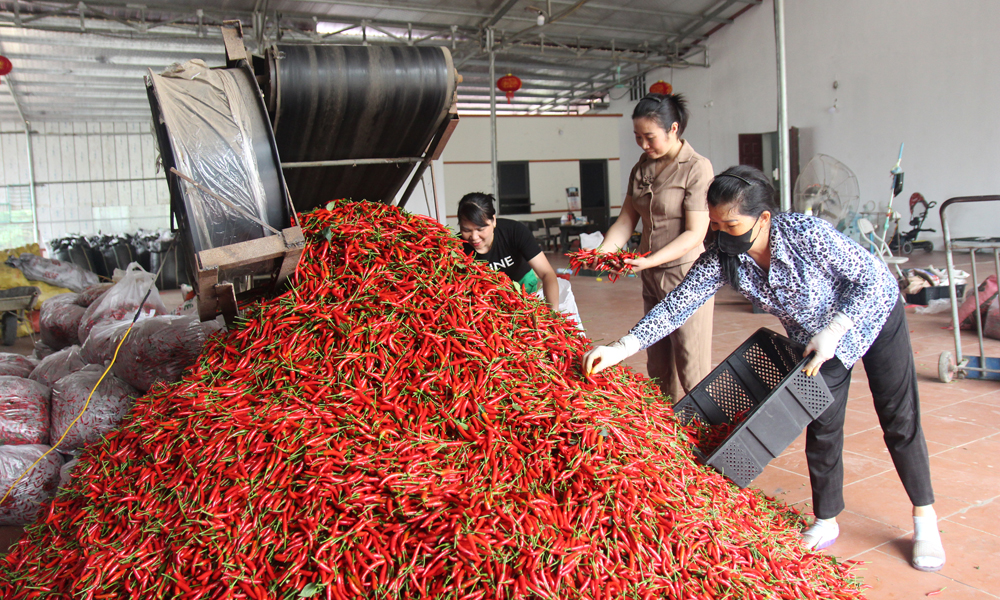Textile and garment enterprises adapt to market fluctuations
Businesses are forced to change, adapt to market developments and expand the scope of customers to increase market share and promote exports, to soon complete their set goals.
In-depth investment
 |
|
Textile and garment production at Nam Dinh Textile and Garment Joint Stock Corporation. |
TNG Investment and Trading JSC posted a total revenue of 4.83 trillion VND in the first eight months of this year, up 3% over the same period last year and equivalent to 71% of the year’s plan. This is a great success for TNG in the context that the textile industry is severely affected by order shortages, a sharp plummet in consumer demand and fierce price competition.
However, the company’s leaders assessed that the market was not very positive, as the number of new orders is lowered than the previous years. The company only has enough orders for production until the end of October and is negotiating orders for the fourth quarter and the early months of 2024.
“In the coming time, the company will focus on investing in modern equipment and improving labour skills of employees to improve product quality and competitiveness, while accepting small orders and fast delivery to maintain production and promote exports,” said TNG Chairman of the Board of Directors Nguyen Van Thoi.
Meanwhile, the Chairman of the Board of Directors of Hoa Tho Textile - Garment Joint Stock Corporation Nguyen Duc Tri said, that the company had to encounter many challenges in the first months of the year, due to unpredictable developments in the market, especially the serious decline in the number of orders and product prices. There were many orders with price decreases of 40-50% compared to previous years.
The company has made every effort to reach its target. It posted a total revenue of 3.2 trillion VND in the first eight months of this year, equivalent to 88% of the same period last year and 72% of the yearly target. The export revenue reached 80 million USD, equivalent to 90% of the same period in 2022 and 80% of the yearly target.
Tri said the market’s purchasing power is forecast to remain low in the first half of 2024. Therefore, the company will not expand production but focus on completing ongoing projects such as the building of the Trieu Phong garment factory (phase 3), the upgrade of the Quang Ngai garment factory, the innovation of machinery and technology to improve production efficiency, the implementation of digital transformation and the construction of a garment research and development centre.
Due to the negative impact of the epidemic and political fluctuations in the world, global economic growth continues to decline from 6% in 2021 to 3% in 2022 and an estimated 2% in 2023. Thereby, the textile and garment industry has been affected by the fall in the number of orders from main markets such as the US, European Union (EU), the Republic of Korea, and others.
Statistics from the Vietnam Textile and Apparel Association (Vitas) also showed that Vietnamese textile and garment exports to the US in the past seven months plummeted by 24%, to the EU decreased by 9.6%, to the Republic of Korea fell by 3.2%, and to China declined by 7.2%. Only exports to Japan went up by 5.1%, equivalent to 2.16 billion USD.
Adapting to market fluctuations
According to Chairman of Ho Chi Minh City Association of Garment, Textile, Embroidery and Knitting Pham Xuan Hong, the textile and garment market, in the final months of the year, has shown signs of warmth again and gradual stabilisation.
Specifically, after a long period of declining orders, recovering demand will boost the consumption of textile and garment products. Despite the order shortage, businesses in this field will find ways to cut costs and increase competitiveness, by receiving small orders and complicated designs with quick delivery, to ensure jobs for workers in the fourth quarter of this year and the following years.
Vitas Chairman Vu Duc Giang said the world’s total textile and garment demand is likely to drop by 8 to 10% this year, so Vietnam’s textile and garment industry will continue to face difficulties until early 2024. The shrink in the export turnover and market share of Vietnam’s textile and garment industry is attributed to the reduction in world demand, the trend of order movement to countries with geographical advantages and the decreasing competitiveness of Vietnamese enterprises.
Vietnamese businesses are facing strict demands on quality standards, compliance with sustainable development policies, circular economy, and standards on labour and production transparency.
Therefore, businesses must quickly change and adapt to market fluctuations. Firstly, they must find solutions to retain workers and organise training courses for green and digital transformation. They must also retain customers by temporarily accepting small orders that are not their strength and are unprofitable to create jobs for workers, as well as building trustworthy and long-term partnerships and exploiting new markets. Finally, it is necessary to reduce unnecessary costs, thereby promoting production and business activities.
According to Chairman of the Board of Directors of Vietnam National Textile and Garment Group (Vinatex) Le Tien Truong, the textile and garment industry in general and Vinatex, in particular, will run into difficulties in the near future, due to the downturn in global textile and garment demand. In addition, the Vietnamese currency is relatively stable compared to the USD, while the currencies of competing countries have depreciated by 10-20% compared to the USD, which affects the export capacity of Vietnamese textile and garment enterprises.
The biggest weakness of Vietnamese textile and garment exporters is their price competitiveness. However, businesses under Vinatex are highly appreciated by their partners for their product quality and completion, flexibility in meeting order requirements and a skilled workforce with the ability to make complex fashion products - an advantage to increase exports. Vinatex plans to produce about 35,000 tonnes of knitted fabric by 2025, with 50% to be exported.
Source: NDO
 Bắc giang
Bắc giang














Reader's comments (0)